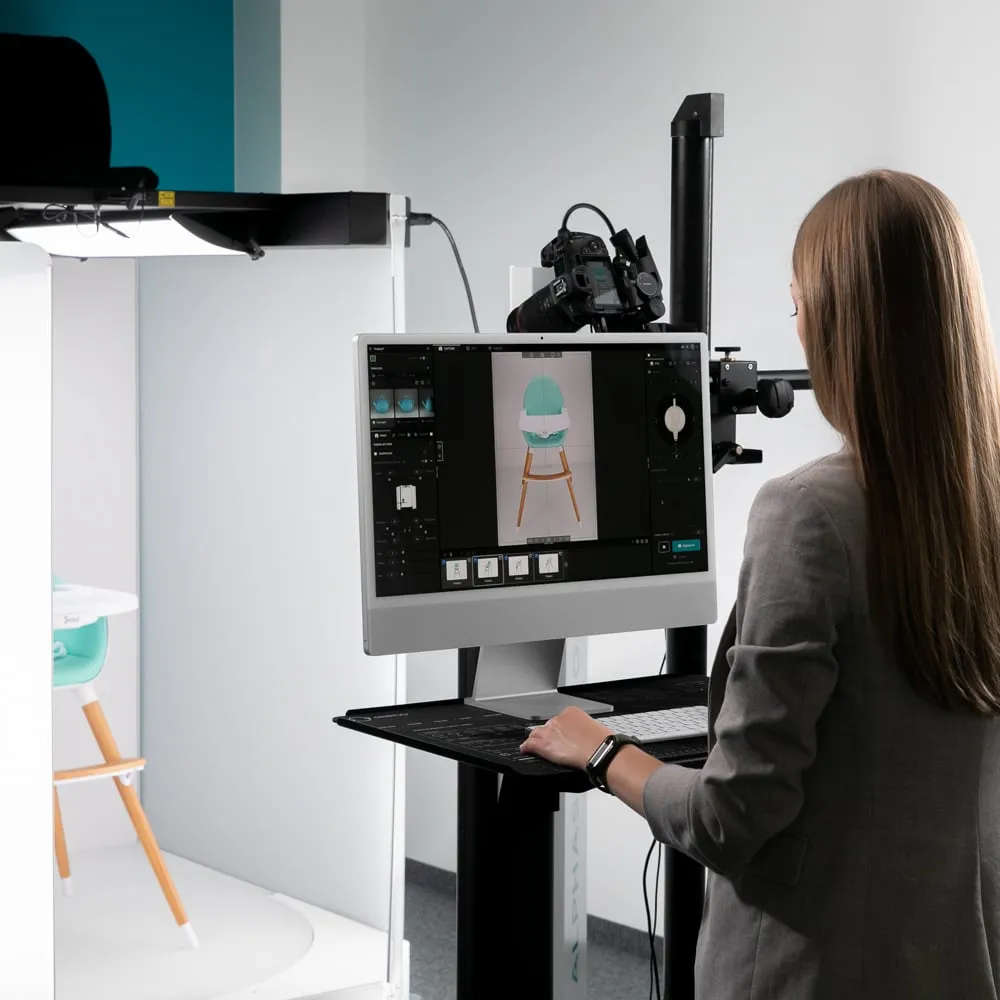

The importance of lighting on 3D animations and 360 object packshots
One automated photo studio makes it possible to produce in-house animated product visuals in record time. It offers a real competitive advantage, by increasing both the productivity, the regularity And the visual quality. Thanks to a synergy between robotic equipment, smart software and advanced lighting system, the creation of 360° or 3D content becomes simple, fast, and above all homogeneous. It is this homogeneity that makes all the difference on an e-commerce site or in an e-catalog.
.webp)
Bringing objects to life: the central role of the in-house photo studio
In an optimized production flow, the robotic system is the heart of the chain. It makes it possible to automate multi-angle capture, while guaranteeing a constant precision of movements. But this device would be nothing without sound software twin : the automated photography software, a true conductor of the settings, the animation and — above all — of the lighting management.
Because when it comes to product photography, lighting is the cornerstone. It's not just about lighting an object properly: it's about revealing its shapes, his Subjects, his transparencies, her texture Or his reflections, while guaranteeing perfect coherence from one visual to another.
Why lighting is strategic for your animated packshots
360° or 3D photography imposes specific constraints. The product is In motion, visible From every angle, and often integrated into interactive interfaces (such as a HTML5 viewer) that allow visitors to rotate it freely. In this context, the least variation in light intensity or a change in exposure becomes immediately visible, and may affect the perception of the product.
That's why a stable, adjustable and repeatable lighting is indispensable. A good system should offer:
- one constant light temperature (generally 5600°K, daylight equivalent),
- Of fine light intensity settings,
- one homogeneous distribution light on the object, even in difficult areas (under the product, transparencies, reflections...) ),
- And the ability to save all of these settings In a profile library usable at will.
Coherence, repeatability and editorial line
In an environment for the production of product visuals, the visual coherence is a success factor. It allows a brand to be immediately recognized, to create a strong visual identity and to inspire trust. To achieve this consistency, it is essential to be able to reproduce identically shooting conditions from one product to another.
The software associated with automated photo studios plays a key role here: it allows remember complete profiles including the light settings, the product positioning, the types of visuals created (still images, 360°, 3D animations), but also the exhibition references. These profiles become real internal standards, facilitating catalog updates, news shootings or product combinations.
.webp)
Optimize exposure for a perfect white background
Photograph on pure white background remains the norm in the majority of e-commerce sectors. But one poorly exposed white background, too bright or slightly greyed out, can compromise the overall rendering. Too many brands are still resigned to going through the manual retouching, which leads to loss of time, additional costs and lack of consistency.
One smart photography software, integrated into the studio, makes it possible to solve this problem beforehand. It automatically detects areas underexposed or overexposed, and adjusts the settings to ensure ideal exposure, without sacrificing product quality or losing detail. This one-click verification makes it possible to produce ready-to-use visuals, without post-processing, with a perfect white background, and without chromatic drift.
Manage complex materials with appropriate lighting
Some products naturally pose technical challenges: transparencies (bottles, glass, plastic), reflective materials (metals, chromes), or white objects on a white background. Again, lighting makes all the difference. It is necessary at the same time modulate the light, the Channel, and sometimes the sculpting, to reveal what the human eye is waiting to see: the density of a fabric, the controlled brilliance of a metal, or the Purity of a glass.
The most advanced automated photo studios incorporate independent light panels, piloted individually, and sometimes even placed under the turntable in order to illuminate the product uniformly, without shadows. This approach makes it possible to faithfully reproduce the appearance of products, including the most demanding ones.
Depth of field and smooth animation
One great depth of field is required for animated packshots: the object being viewed from multiple angles, it must remain net in all positions. This requires a precise combination of aperture settings, light intensity, and capture speed. One software control of the turntable and the light sources, via precision microprocessors, makes it possible to reach this level of fluidity while maintaining a consistent quality frame after frame.
A sustainable investment
Investing in a optimized lighting For photography automated product is not an option. It is a strategic choice. Far too often, businesses invest in an efficient system but try to reduce light costs. However, poor lighting compromises the promise of visual quality that automation must precisely guarantee.
With the experience acquired since 2003, PackshotCreator has been able to see that customers who have chosen a reliable and calibrated lighting equipment, rather than considering it as a simple accessory, have consistently obtained lasting professional results, a drastic reduction in post-processing time, and a significant increase in conversions online.



